On June 18, a Twitter feed associated with Ansar al Sharia in Libya posted a link to a 30 minute audio recording of the group’s weekly radio broadcast covering news and events in Benghazi and elsewhere in Libya. The recording was the 24th such broadcast aired.
Nearly two minutes into the program, the host asked Allah to accept the organization’s first leader, Mohammed al Zahawi, as a martyr. The host then asked Allah to protect and bless Zahawi’s successor, a jihadist known as Abu Khalid al Madani.
In January, al Madani issued Ansar al Sharia’s eulogy for Zahawi. Little else is publicly known about al Madani. Then again, little was known about Zahawi, even though he was much more of a public personality than his successor. For example, Zahawi’s meeting with Osama bin Laden in the 1990s was not publicly acknowledged until after his death.
During the Ansar al Sharia radio broadcast, al Madani said that his group and the ummah (global community of Muslims) would “not be able to cast off our humiliation unless we wage jihad.” This is a standard jihadist motif, harkening back to the glory days when Islamic empires ruled over vast territory. Al Madani continued by saying that Allah’s authority must be reestablished and the world is waiting for the jihadists to liberate the Al Aqsa Mosque from the Jews.
Al Madani’s speech, which commemorated the beginning of Ramadan, lasted several minutes. The broadcast then turned to other matters, including the recent US airstrikes in Ajdabiya, Libya, where the al Qaeda veteran Mokhtar Belmokhtar was thought to be attending a meeting.
Belmokhtar apparently survived the bombings, but several fighters from Ansar al Sharia were killed. The radio show referenced the statements issued by Ansar al Sharia and the Ajdabiya Shura Council (ASC), a coalition of groups, both of which implicitly denied that Belmokhtar had been killed. Ansar al Sharia and the ASC listed the “martyrs” killed in the US airstrikes, leaving Belmokhtar off the list and saying that no one else had perished. (Ansar al Sharia operates as part of the ASC, leads the Benghazi Revolutionaries Shura Council, and has joined other alliances as well.)
However, the infrequent US airstrikes are hardly Ansar al Sharia’s most pressing concern. The group has been engaged in heavy fighting against General Khalifa Haftar’s pro-government forces for more than a year. And the two sides have been wrestling for control of Benghazi ever since Haftar launched Operation Dignity in May 2014.
Ansar al Sharia has suffered significant losses, including key leaders such as Zahawi. But Ansar al Sharia fights on. And the group continues to distribute its propaganda through a network of “reporter” sites on Twitter, in addition to its own official Twitter feed, which has been repeatedly suspended.
On June 22, for instance, Ansar al Sharia’s propagandists posted a pictorial report documenting an assault on a barracks filled with Haftar’s men in the “western sector” of Benghazi. Ansar al Sharia claims to have initiated the attack with a “remote-controlled” car bomb. Cover fire from artillery and mortars then supposedly allowed the jihadists to rout Haftar’s soldiers. (The photo set can be seen at the bottom of this article.)
As is customary for the jihadists, the group posted a separate photo set documenting the “spoils” from its successful raid on the army barracks. However, the haul was somewhat meager when compared to previous operations. Two beat up trucks, each carrying a heavy gun, were pictured.
Other recent propaganda photos focus on the organization’s charitable efforts in Benghazi, Derna, and other towns in Libya. Some of the images show members of Ansar al Sharia’s “General Services Directorate” handing out gas cylinders to families living in the areas under the jihadists’ control. Other photos show the group’s fighters delivering “household items” to “needy families” in Derna.
There has been much speculation concerning Ansar al Sharia’s relationship with the Islamic State. Contrary to various erroneous accounts, Ansar al Sharia has not joined Abu Bakr al Baghdadi’s “caliphate.” Some members of the group have defected to the Islamic State and the two groups have cooperated in attacks inside Benghazi, but Ansar al Sharia as a whole has not endorsed Baghdadi. This may be due to its relationship with al Qaeda in the Islamic Magreb (AQIM), an official branch of al Qaeda that remains loyal to Ayman al Zawahiri, and its ties to other al Qaeda loyalists, such as Belmokhtar.
And al Madani has apparently resisted calls to merge Ansar al Sharia into the Islamic State’s fold. For instance, Ansar al Sharia’s top sharia official, Abu Abdullah al Libi, pledged his allegiance to Baghdadi earlier this year. But al Madani’s men did not follow suit. Ansar al Sharia simply appointed another jihadist, Abu Tamim al Libi, to serve as its senior sharia official.
Ansar al Sharia’s propaganda also does not support the view that the group has merged with the Islamic State.
On June 21, Ansar al Sharia tweeted a link to its weekly newsletter, “This Is Your Ummah, One Ummah.” The pdf publication includes a summary not only of Ansar al Sharia’s activities, but also those of other jihadist groups.
The news section of the newsletter contained a summary of al Qaeda in the Arabian Peninsula’s eulogy for Nasir al Wuhayshi, who served as AQAP’s emir and al Qaeda’s global general manager until he was killed in a US drone strike. (A screen shot of the statement on Wuhayshi’s death, as republished by Ansar al Sharia, can be seen on the right.)
The news section also included short descriptions of attacks committed by other jihadist organizations, including the Islamic State and Shabaab. The inclusion of propaganda from the Islamic State does not mean that Ansar al Sharia has joined Abu Bakr al Baghdadi’s “caliphate.” If the group had switched loyalties from al Qaeda’s network to Baghdadi, then the Islamic State would have heavily advertised it. Moreover, it is not likely that any group loyal to the Islamic State would honor Wuhayshi, who rejected Baghdadi’s gambit to become the new “caliph” outright.
Both the UN and the State Department have reported that Ansar al Sharia’s branch in Derna has sworn allegiance to the Islamic State. In its recently released Country Reports on Terrorism for 2014, for instance, the State Department claimed that Ansar al Sharia in Derna “pledged allegiance to” to the Islamic State in October 2014. But this is not true.
As noted above, the Islamic State would have heavily promoted this oath of allegiance had it been sworn. Neither the Islamic State, nor Ansar al Sharia in Derna, issued an official statement saying this had happened.
Ansar al Sharia continues to independently publish propaganda promoting its activities in Derna. This propaganda is branded with Ansar al Sharia’s name, logo, and other markings. Had the group lost its entire Derna wing to the Islamic State, then Baghdadi’s organization would have subsumed it into one of its wilayats (or provinces) and marketed its activities on behalf of the “caliphate.” While Ansar al Sharia occasionally uses the black banner typically associated with the Islamic State, it uses the al Qaeda-style flag in its official propaganda. (See the photos below.)
In addition, Al Wasat, a Libya-based publication, reported on June 23 that two Libyan soldiers were killed outside the southern entrance of Derna during fighting between Ansar al Sharia and the Libyan Army. Al Wasat also claimed that Ansar al Sharia had fought alongside other al Qaeda-affiliated militias in Derna against the Islamic State’s fighters. These other militias belong to the Mujahideen Shura Council in Derna, which began battling the Islamic State’s branch earlier in the month.
Another recent message from Ansar al Sharia shows that it isn’t part of the Islamic State’s international network. On June 24, the organization tweeted a banner asking and answering the question, “What Do We Fight For?” There is no mention of Baghdadi’s “caliphate” in the banner, which can be seen on the right.
Ansar al Sharia explained that it does not “fight for this world nor for a certain position, glory, reputation, or admiration.” Instead, “we fight in defense of our religion, to establish the rule of God, and to follow the commands of our creator.”
More than two and a half years after the September 11, 2012 terrorist attack, which made Ansar al Sharia infamous in the West, the organization is still trying to achieve these goals.
Below are Ansar al Sharia’s photos showing the use of a “remote-controlled” car bomb, artillery and mortars in an assault on June 22 on a barracks belonging to General Haftar’s men in Benghazi:


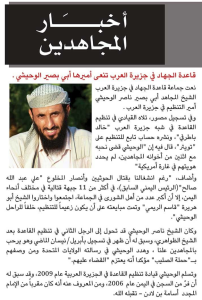
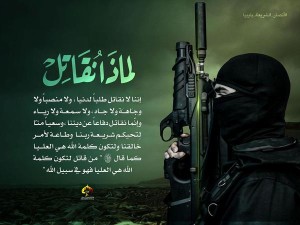
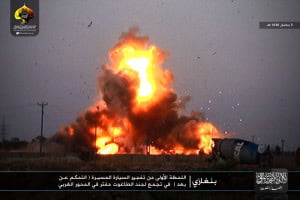
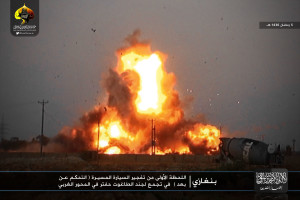
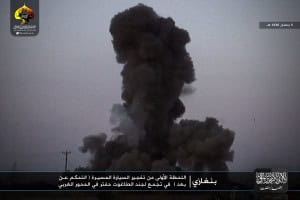

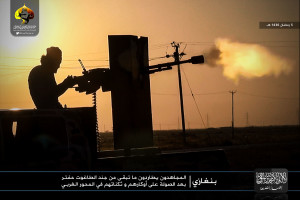
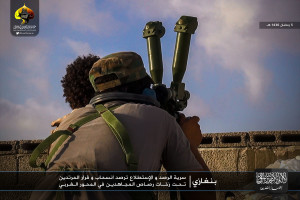


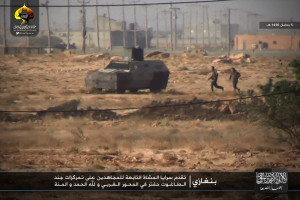


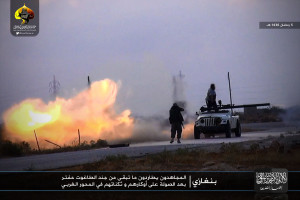







5 Comments
what the heck is that thing in the fourth picture up from the bottom? Looks like a technical up-armoured with steel plates.
thanks for the insight. Very useful in trying to determine/understand where the various nodes of communication are taking place between the different Terrorist Organizations’ hierarchies. Its obviously shifting constantly based on a host of variables, factors, elements, etc.,.
@ W Fenwick
Mad Max? Zombie Apocalypse? Appalachia Moon Shiners? Jersey Junkyard? Baghdad Taxi?
I’m curious about the heavy automatic weaponry these people are using. Russian? And the logistics of getting ammunition to the places of battle are pretty demanding. Who is helping them with weaponry, ammunition and logistics?
AC Falk
you probably nailed it. Lots of homemades and one-offs like that over there. Anyone with a torch… Look at how they have been armoring up their SVBIEDs to enable them to get the vehicles in to engagement range before boom.